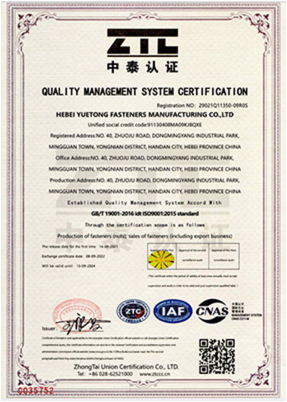Nov . 09, 2024 04:05 Back to list
Exploring Various Clamp Types for Secure and Versatile Applications
Understanding Clamp Types Applications and Importance
Clamps are essential tools in various fields, from woodworking and metalworking to electronics and construction. Among the numerous types of clamps available, each serves a specific purpose, making them invaluable in both professional and DIY projects. This article explores different clamp types, their applications, and their significance in various industries.
1. C-Clamps
C-clamps are one of the most common types of clamps. Their C-shaped design allows them to hold materials securely together. They are primarily used in woodworking and metalworking to hold workpieces in place while cutting or assembling. The adjustable screw mechanism enables precise pressure application, making C-clamps versatile for various tasks. They are available in different sizes, enabling their use in both small and large projects.
2. Bar Clamps
Bar clamps, also known as pipe clamps, are another widely used type of clamp. They consist of a long bar with movable arms that can be adjusted to accommodate different widths. Bar clamps are particularly useful for gluing large panels together, as they distribute pressure evenly across the surface. Their ability to open wide makes them ideal for clamping materials of various sizes. In woodworking, bar clamps are often used in furniture assembly because of their strength and reliability.
3
. Spring ClampsSpring clamps are lightweight and easy to use, featuring a spring-loaded mechanism that allows for quick clamping. They are perfect for temporary applications where speed is essential. While not as strong as C-clamps or bar clamps, spring clamps are ideal for holding small pieces in place during tasks like painting or glue application. They come in various sizes, making them useful for a multitude of small-scale projects.
clamp types

4. Locking Clamps
Locking clamps, often referred to as Vise-Grips, represent a robust solution for securing objects tightly together. They have an adjustable screw that allows the user to set the clamping pressure, which is then locked into place, providing a strong hold. Locking clamps are frequently used in metalworking and automotive applications, particularly in welding and fabricating operations, where a secure grip is critical.
5. F-style Clamps
F-style clamps, also known as F-clamps, are similar to bar clamps but have a more streamlined design. The F-shaped frame allows for easier access while clamping materials, particularly in tight spaces. With a sliding arm, these clamps can quickly adjust to different widths, making them versatile and convenient for various applications. They are often used in woodworking and cabinetry, offering stability and strength during assembly.
6. Edge Clamps
Edge clamps are designed specifically for securing the edges of materials, often used in applications like veneering or laminating. Their design allows for a secure grip without damaging the surfaces of the materials being clamped. Edge clamps are particularly helpful in ensuring a flush and even bond, contributing to the overall quality of finished products.
Conclusion
Understanding clamp types and their respective applications is crucial for anyone working with materials in construction, woodworking, or manufacturing. The correct use of clamps not only enhances the quality of the work but also ensures safety by providing the necessary stability during operations. As you explore different projects, recognizing the right clamp for the job will enable you to work more efficiently and effectively, ensuring a successful outcome. Whether you're a professional tradesperson or a DIY enthusiast, the variety and application of clamps are fundamental in achieving precision and reliability in your work.


